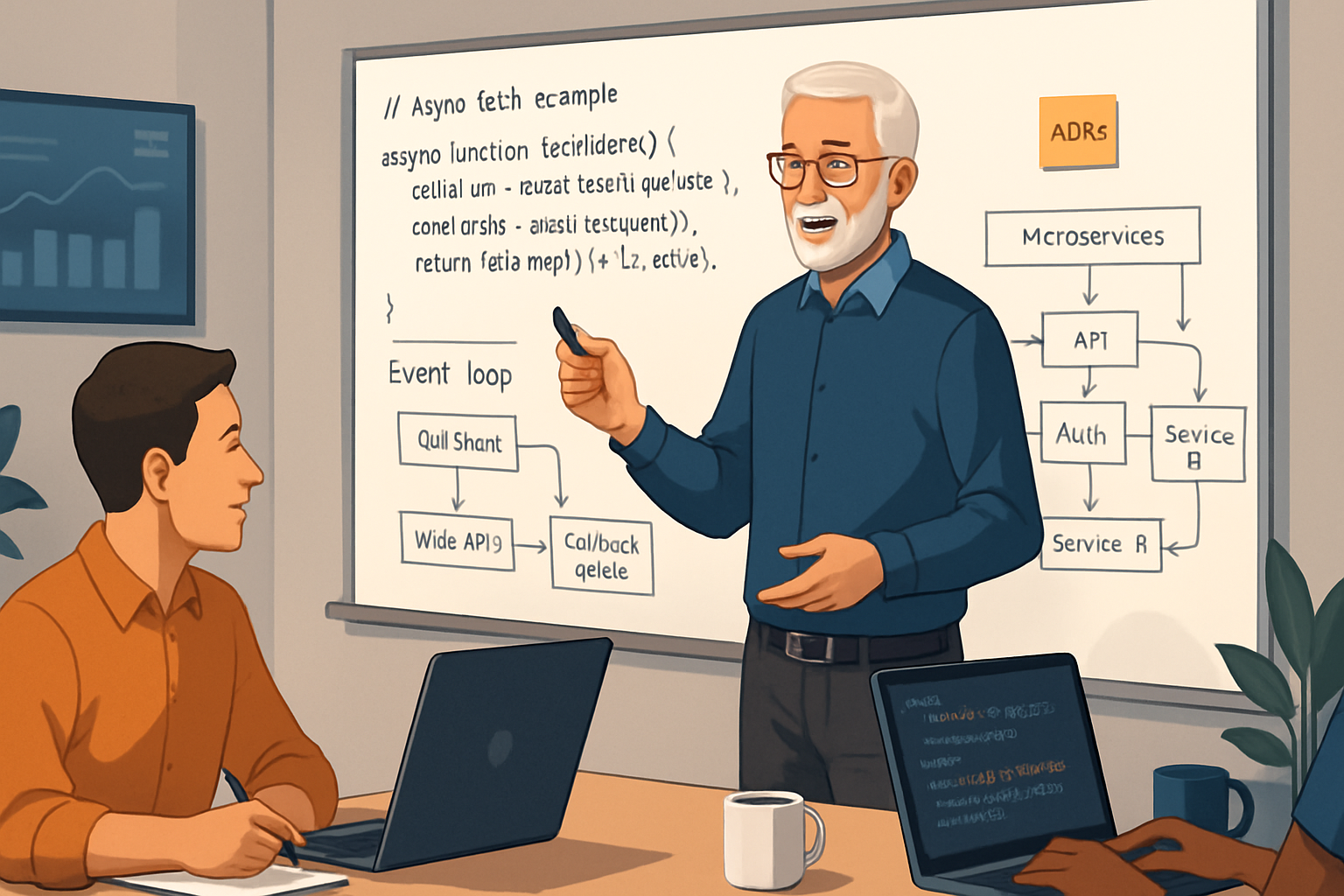· career · 5 min read
The Overlooked Importance of Soft Skills in JavaScript Development
Neglecting soft skills can stall a JavaScript engineer's career. Learn why communication, empathy, and teamwork matter, and get practical exercises, templates, and metrics to improve collaboration and unlock opportunities.

Outcome first: sharpening a few soft skills will make your codeship sail smoother - fewer rewrites, faster launches, clearer promotions, and better teammates. You’ll ship features with less friction and be the person people ask when the project gets hard.
Why this matters now
Technical skills get you in the door. Soft skills get you promoted, trusted, and invited to design the roadmap. JavaScript ecosystems move fast. Teams are distributed. Problems are social as much as technical. When communication or collaboration breaks down, even small apps regress into churn: duplicated work, slow code reviews, and feature flag nightmares.
The World Economic Forum and industry surveys consistently list communication, collaboration and problem-solving among the top skills employers want - not just raw coding ability (World Economic Forum). For developers specifically, community and teamwork show up again and again in surveys and hiring criteria (see the Stack Overflow Developer Survey for trends over time: https://survey.stackoverflow.co/).
What gets overlooked (and why it hurts)
- Poorly framed questions. You spend hours debugging because nobody explained the constraints.
- Defensive code reviews. Comments read as personal attacks; reviewers block progress instead of guiding it.
- Meetings that are monologues. Time drains with little decision-making.
- Weak ownership. Integrations fail because no one coordinated the edge cases.
Consequences are measurable: slower delivery, lower engineering morale, repeated bugs, and missed promotions.
Real-world scenarios (and the soft-skill fixes)
Scenario: Two engineers build overlapping modules and merge conflicting assumptions into production. Fix: A quick sync ritual and a shared interface contract before coding. One 15-minute alignment call prevents a full-day rollback.
Scenario: A code review thread devolves into tone policing and pedantry. Fix: Use a clear review goal (functionality, architecture, tests) and a kindness-first comment style. Start with what’s good, then suggest improvements.
Scenario: Remote onboarding leaves a new hire confused and stalled. Fix: Create a short onboarding checklist with 1:1 meetings, small first tasks, and a buddy system.
Actionable soft-skill improvements (with exercises and timeframes)
These are concrete, repeatable, and designed for engineers with packed schedules.
- Communication: structure and clarity
- What to practice: one-line summaries + 2–3 bullet context for every issue or PR.
- Exercise (10–15 min daily): before creating an issue or PR, write a 1-sentence goal and a 3-bullet context. Post it. Iterate on feedback.
- Why it works: reduces back-and-forth and makes reviewers productive.
- Code reviews: teach, don’t scold
- What to practice: the “Praise - Question - Suggest” pattern.
- Exercise (20 min per review): leave at least one explicit praise, one clarifying question, and one suggestion.
- Short template:
- “Nice work on X - this handles Y well.”
- “Quick question: what happens if Z?”
- “Suggestion: consider extracting W for clarity - here’s a quick example…”
- Running effective meetings
- What to practice: agenda + timebox + single outcome.
- Exercise (5 min prep): write the meeting goal in the invite. End with: decision, action owners, and deadline.
- Why it works: prevents slippage and meeting fatigue.
- Empathy & perspective-taking
- What to practice: assume positive intent; ask before criticizing.
- Exercise (weekly, 10 min): read a teammate’s recent PR and write what constraints they might have had.
- Why it works: reduces friction and increases trust.
- Conflict resolution
- What to practice: describe, don’t accuse. Use data.
- Script to try:
- “I noticed X happened and here’s the data. I’m concerned because Y. Could we try Z?”
- Exercise: role-play with a peer once a month for 20–30 minutes.
- Presentation and story-telling
- What to practice: start with the outcome, then backfill tech details.
- Exercise (15–30 min): prepare a 3-slide demo: Problem, What we built, Results.
- Why it works: stakeholders act faster when they see value quickly.
- Mentorship and giving feedback
- What to practice: use the feedback sandwich sparingly and be specific.
- Exercise: once a week, give a 5-minute focused feedback to a peer - two positives, one improvement with an example.
- Time management and asynchronous collaboration
- What to practice: predictable overlap windows; clear SLAs for responses.
- Exercise: decide with your team 1-hour core overlap and set response expectations (e.g., 24h for non-urgent PRs).
How to measure progress (practical metrics)
Soft skills feel fuzzy. Make them measurable.
- PR Cycle Time: time from PR open to merge. Shorter can indicate clearer communication and faster reviews.
- Review Comment Sentiment: track ratio of positive vs. corrective comments (manual sampling or a lightweight script).
- Meeting Effectiveness: percent of meetings that end with action items and owners.
- Onboarding Time: time until a new hire completes first merge and shipping task.
- 360 Feedback: quarterly anonymous pulse asking teammates about communication, clarity, and collaboration.
Pick 2–3 metrics, track them for a quarter, and correlate with release velocity or bug rate.
Quick templates you can copy
PR description template:
- Goal: One-liner.
- Context: 2 bullets (why now, constraints).
- What changed: bullet list of files/areas.
- How to test: steps and expected results.
Feedback starter:
- “I value X. Recently I noticed Y which made me concerned because Z. Could we explore doing A differently?”
Meeting invite text:
- “Goal: Decide between A and B. Bring: data on X. Outcome expected: chosen option + owner + timeline. Timebox: 30 minutes.”
How to introduce a culture change on your team
Start small. Pick one ritual (PR structure or meeting agenda) and run it for 4 weeks. Measure a concrete metric (PR cycle time, meeting outcomes). Share results in a retro. Celebrate wins publicly; normalise trying improvements and rolling back if they don’t work.
Leadership matters. If senior devs model empathy, timely reviews, and clear communication, others follow. If they don’t, process changes will feel like extra bureaucracy.
Resources (books and courses worth your time)
- Team Geek - Ben Collins-Sussman, Brian Fitzpatrick, and Chris Beams (team dynamics and engineering culture) https://www.oreilly.com/library/view/team-geek/9781449319242/
- Crucial Conversations - Patterson, Grenny et al. (handling high-stakes conversations) https://www.hayhouse.com/
- The Pragmatic Programmer - Hunt & Thomas (practical career-level advice) https://pragprog.com/book/tpp/the-pragmatic-programmer
- World Economic Forum - Future of Jobs (skills trends) https://www.weforum.org/reports/the-future-of-jobs-report-2020
- Coursera / LinkedIn Learning courses: Communication and Emotional Intelligence courses (search your platform of choice)
Final note - what to do tomorrow
Pick one tiny habit: start every PR with a one-line goal + test steps. Do that consistently for a week. Watch how reviewers respond. Iterate.
Soft skills don’t replace technical skill. They multiply it. Invest in them deliberately. Your next promotion, smoother release, or trusted architect role might hinge on how well you talk, listen, and collaborate - not just how fast you write a function.



